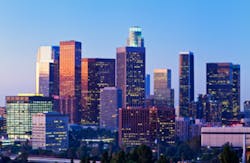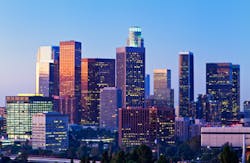The U.S. Environmental Protection Agency (EPA) released a list of U.S. metropolitan areas with the most Energy Star certified buildings in 2012, with the aim of highlighting how owners and managers of commercial buildings across the country are taking action on climate change while delivering real bottom line savings.
For the fifth year in a row, Los Angeles continues to hold on to first place, with 528 buildings. Washington, D.C., with 462 buildings, is a competitive front-runner. In third place, with 353 buildings, Chicago has risen through the rankings each year, starting in sixth place in 2008 and increasing the number of buildings certified by an average of 32 percent each year. New York, which recently required its commercial buildings to publicly disclose their energy use, secured fourth place.
In 2012, the EPA says more than 20,000 Energy Star certified buildings across America helped save more than $2.7 billion in annual utility bills while preventing greenhouse gas emissions equal to emissions from the annual electricity use of more than 2 million homes.
Energy use in commercial buildings accounts for 17 percent of U.S. greenhouse gas emissions at a cost of more than $100 billion per year. The EPA said it continues to see an increase in buildings applying for and earning Energy Star certification each year. The cumulative number of Energy Star certified buildings has increased by more than 24 percent compared to last year, representing more than 3 billion square feet of floorspace nationwide. In 2012 alone, more than 8,200 buildings earned EPA’s Energy Star certification.
Phoenix broke into the top 10 for the first time, with 202 buildings. Boston, a newcomer to the list last year, held on to 10th place, with 11th-place Philadelphia not far behind. Seventh-place Houston, with 241 buildings, is home to one in particular that stands out: Phoenix Tower, a 34-story office building, has earned EPA’s Energy Star 14 times—more than any other building in America.
Commercial buildings that earn EPA’s Energy Star must perform in the top 25 percent of similar buildings nationwide, as verified by a professional engineer or a registered architect. Energy Star certified buildings use an average of 35 percent less energy and are responsible for 35 percent fewer greenhouse gas emissions than average buildings. Fifteen types of commercial buildings can earn the Energy Star, including office buildings, K-12 schools, and retail stores.
For a complete list of Top Energy Star Cities, visit http://energystar.gov/topcities.



